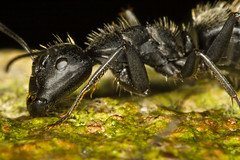I often get asked how I get so much depth of field in my photos. There isn’t any magic to it really, it’s just technique. Here are some tips to help you get as much depth as possible.
Don’t be afraid to stop the lens down. Diffraction can be a problem, but I frequently shoot at F16 when I’ve got all my tubes and a diopter attached to my lens (about 2.75 times life size). Rarely does diffraction become a big issue with Canon’s 100mm macro lens unless you go above F16, and I’d probably shoot at F22 for life size shots if I needed the extra depth of field. If you don't like the diffraction softening then bring the Fstop down to F11 at 2x or F8 at 3x.
Remember that the plane of sharp focus is perpendicular to your lens and although it’s flat it has some “thickness” to it. If you move in toward a critter until its eyes are in focus, and then press the shutter release, then the plane of sharp focus starts at the eyes and ends somewhere between the critter and your lens –possibly out in the middle of nowhere in an area that you don’t need it! Often I move in toward an insect until the eyes are in focus and I keep moving in until they go out of focus again, and then I move away from it until the eyes are sharp and then take the shot. That way the area of sharp focus starts at the critter’s eyes and extends into its body where I need the extra detail…
Look for “magic angles”. Since the plane of sharp focus is perpendicular to the lens you can lay it over your subject so that it covers the critter like a blanket. You can make a scene look like there is more depth of field than what is really there. If you are shooting an insect from the side it’s a good idea to make sure the lens is perpendicular to the plane of its body so that the entire length of critter is in sharp focus –but it’s not necessary to do it all the time. You can use a shallow depth of field to draw the viewers attention to a particular area in a scene, so going for maximum depth of field all the time might be a mistake...
For the shot I’ve attached to this post I wanted the front leg to be in focus since an out of focus leg close to the ant’s face might be distracting. So I moved in until the eyes were in focus and then looked for “texture” –in this case the hair on the ant's legs. Once you’ve been shooting a particular critter for a while you can start to pick up on their unique textures. Body hair, scales, the lenses in the compound eyes, etc are all good examples. Use those textures as a visual clue to tell you when the area of sharp focus is where you want it to be.
I always take more than one shot of a particular composition, and I refocus the lens for every shot. I frequently shift the area of sharp focus from frame to frame just a little because sometimes a scene that looks good through the viewfinder doesn't look good when I get the image on my computer. Also shifting the focus can change the way a photo looks and feels -something that might not be easy to see in the view finder but very noticable on screen or in a print…
These are just tips and not rules etched in stone. How you use depth of field is a part of developing your own photographic style, so experiment and practice –lots of practice…
Happy shooting!
Footnote: After reading the first comment and looking over this post it dawned on me that I didn't mention the mechanics of focusing the scene. You can use the focus ring on the lens, or you can set the focus ring to any magnification you desire (most macro lenses have magnification marks on them) and move your body to adjust the focus. Either way is fine, and is really up to you. Last year I used the focus ring almost all the time and I locked my body in place. This year I use the "rock back and forth" method almost exclusively. And sometimes I use the focus ring like a course focus to get the composition that I want and then move my body to fine tune the scene. The best advice I can give you is to simply experiment and see what works for you...


2 comments:
I've read several people (I think even Mark Plonsky) advocate leaving the lens focused at infinity and moving yourself forward and back instead-especially when you are hand-holding your rig. Do you find it easier with the chest-mount to focus via the ring instead?
Actually the lens would be set to the closest distance for maximum magnification.
I can focus the lens either way -sometimes using the focus ring and sometimes using the rock back and forth method. Either way works fine with the chest mount.
The funny thing is that last year when I first started shooting macro it was difficult for me to rock back and forth and lock the focus so I switched to using the focus ring. This year I've used the rock back and forth method almost exclusively. Sometimes I use the focus ring to get the composition that I want and then fine tune the focus by moving my body (a lot of my recent butterfly closeups where taken that way).
Post a Comment